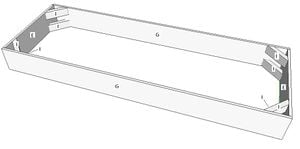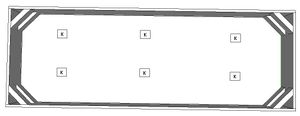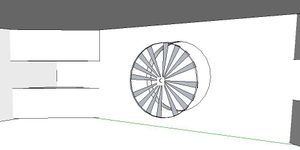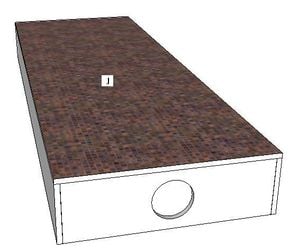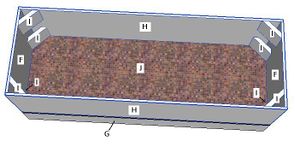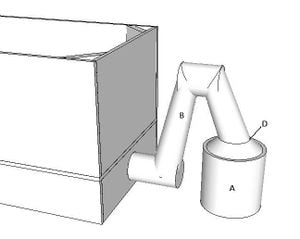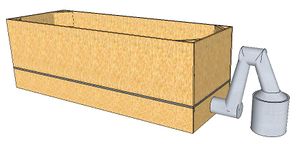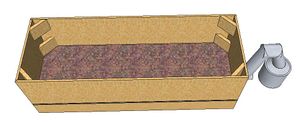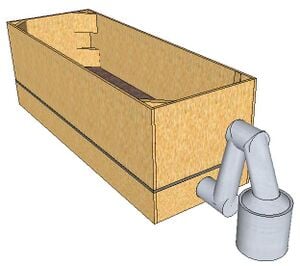
This article features instructions on how to build a fixed batch heated air drying bin from local materials. For further information on rice farming and appropriate practices, see Rice.
Methods of Drying[edit | edit source]
Field Drying[edit | edit source]
- Rice is left to dry in fields
- Very low relative cost
- Advantages: Loosens panicles for ease in threshing
- Disadvantages: Very poor quality rice, cannot dry in rain (eg. wet season) or at night[1]
Sun Drying[edit | edit source]
- Rice dries on pavement or drying mats by heat from the sun
- Very low relative cost
- Advantages: Better quality than field drying, relatively inexpensive
- Disadvantages: Poor milling quality, labor intensive, cannot dry in rain (eg. wet season) or at night[1]
Heated-Air Drying[edit | edit source]
Fixed-Bed Dryer
- Heated air flows through batch
- Low relative cost ($150 for circular batch – also can be considered in-store dryer due to long drying time, see below – and $1500 for flat bed)[2][3][4]
- Advantages: Simple, inexpensive, fast drying
- Disadvantages: Reduction in milling yield (due to re-wetting of dry grains), risk killing seeds, labor intensive[1]
Re-circulating Batch
- Rice moves through sections that alternately dry and temper it
- Medium relative cost ($10,000)[3]
- Advantages: Good quality yield, large capacity, low labor for mixing, lower moisture gradient
- Disadvantages: Requires servicing and skilled laborers, moving components[1]
Continuous Flow Dryer
- Rice and air flow in two distinct directions
- High relative cost (large scale productions)
- Advantages: Large capacity
- Disadvantages: Complicated mechanisms[1]
In Store Drying[edit | edit source]
- Low temperature deep bed drying
- High relative cost (large scale productions)
- Advantages: Energy efficient, large bins, excellent grain quality, dries in storage
- Disadvantages: Very long drying time, need bulk handling system, risk spoiling with faulty power supply[1]
Additional Notes[edit | edit source]
Research done into enhancing sun drying with solar collectors has shown that the sun cannot be intensified enough to increase drying time enough to justify the added cost. Also, just like sun drying, solar collectors cannot be used to dry rice at night or in the rain.[1]
Economics of Drying[edit | edit source]
There are several apparent economic benefits to using mechanical dryers to dry rice. These include an increased market value of the higher quality product, more secure income from reduced weather risks, and the ability to process more grain in a given amount of time. In addition, most markets sell rice by weight or by volume. Drying reduces both the weight and volume of the paddy.[1]Generally, in order to justify the cost of drying rice mechanically, the increased profit due to higher rice quality must outweigh the cost of installing and running the machine as well as the loss in weight or volume of the paddy. Taking into account other economic considerations including maintenance, depreciation, and interest, it is very difficult to break even over the lifespan of a mechanical dryer in small-scale operations.
Flat bed fixed batch dryers (heated air drying fixed batch flat bed dryers) are the most commercially successful mechanical dryers and are most often used in small to medium sized rice mills. Although they may not offer the best technical solution to drying rice, they seem to balance the cost and profit requirements well. The Vietnamese Flat-Bed Dryer (over 6000 installations at a cost of $1500) has a capacity of four to ten tons and can dry the rice in six to eight hours. The IRRI Flat-Bed Dryer ($1000) has a capacity of one ton and can dry the rice in six to eight hours. According the IRRI's website, the dryer has been installed thousands of times since the 1970's however admits that the design is very outdated.[3][1]
The circular batch dryers (low temperature deep bed dryers) have experienced modest success. Examples include the IRRI seed dryers and the Vietnamese Low Cost SRR and SRT dryers. Although relatively inexpensive ($100-$150), they have small batch sizes (maximum one ton) and take one to two days to dry the rice.[3][1]
As a general rule, a dryer should reduce moisture content at a rate of one percent per hour to be considered efficient. For example, if you wish to reduce the moisture content of your paddy from 22% to 13% (for a storage time of eight to 12 months), your dryer should be able to dry the rice in nine hours.[1]
Design[edit | edit source]
The goal of this design was to create a dryer that could maintain rice quality at a low capital and operating cost yielding a reasonably high dry time while remaining accessible to small-scale processing. The fixed batch dryer produces good rice quality and has a fast drying time, however it has a high capital and operating cost. These costs are primarily associated with the type of material used, fuel, and complexity of the machine (requiring skilled laborers to repair). Because of the number of units sold of the fixed bed dryers compared to the circular batch dryers, the fixed bed dryer is obviously preferred. Therefore, this design sought to optimize the current fixed bed dryer by incorporating successful features of the circular batch dryer.
Larger scale fixed bed batch dryers have a 4-10 ton capacity and are fueled by large furnaces, while the smaller scale circular batch dryers are fueled by small coal, wood, or rice husk fires. Fixed bed batch dryers, due to their large capacity, are often made of metal while the circular batch dryers are often made from less expensive local materials such as bricks and bamboo. Both utilize a metal wire mesh to keep rice in place while allowing warm airflow through batch. They also both use inexpensive axial fans to propel air through the system.[5][6][7][4]The redesigned fixed bed dryer is made from less expensive local materials, similar to the circular batch dryer. It is also fueled by burning biomass in the form of rice husks.[8]This decreases operating costs and, along with the appropriate heat transfer system, produces a higher temperature than the circular batch dryers.
Circular batch dryers dry the rice at a small temperature differential while fixed bed dryers dry rice at a higher temperature (optimal at 43oC). This allows circular dryers to have a much smaller moisture gradient. A high moisture gradient in the batch allows for re-wetting of rice with lower moisture content, which reduces rice quality. To reduce the moisture gradient in the fixed bed dryer, the rice is not to be at a depth greater than 70 cm.[9][10]
Evaporation of Water[edit | edit source]
Rice drying is characterized by an uneven evaporation of moisture. In the preheating period, most of the heat supplied to the rice is used to heat the rice up, so very little evaporation occurs. Next, in the constant-rate period, the rice is fully heating and water is evaporating from the surface of the grain. Next, in the falling-rate period, the moisture from the surface of the grain is nearly all evaporated and moisture from the interior of the grain must make its way to the surface before evaporating. This drastically slows the rate of evaporation and causes the rice grains to further heat up.
In designing this apparatus, the evaporation rate was calculated to estimate drying time for different designs. The rice was assumed to have a constant rate of evaporation. However, due to the falling-rate period, this assumption causes the calculated drying time to be slightly lower than is should be to reach the desired moisture content.
Evaporation rate of water in a large pool is given by:[11]
and
where
- g is the amount of evaporated water in kg/h
- k is the evaporation coefficient in kg/m2h
- v is the wind velocity in m/s
- A is the area is m2
- x is the saturation humidity at the surface temperature (43 degrees Celsius for optimum drying) in kg water/kg air
- h is the relative humidity of the ambient air
The desired amount of water to be removed from the rice is given by:
where
- d is the desired amount of water to be remove from the rice in kg
- m is the initial mass of the rice
- MCo is the initial moisture content (usually between 20% and 25%)
- MC is the desired moisture content (usually between 9% and 14%)
The total drying time is given by:
where
- t is the total drying time in hours
For drying a ton of rice the re-designed fixed bed batch dryer from 22% to 13% moisture content at the ideal drying temperature of 43 degrees Celsius with a calm breeze of 1 m/s at 60% relative humidity, the drying time for the 1x3 meter dryer is 7 hours.
Heat Loss Analysis[edit | edit source]
The following figure shows the equations and diagram for determining heat loss through a pipe of length L with inner diameter r1 and outer diameter r2 with conductive heat transfer coefficient of k containing a hot fluid with temperature Tinf1 and convective heat transfer coefficient of h1 surrounded by a cold fluid with temperature Tinf2 and convective heat transfer coefficient of h2. Ts1 and Ts2 refer to the surface temperatures of the pipe on the inner and outer diameters, respectively.[12]
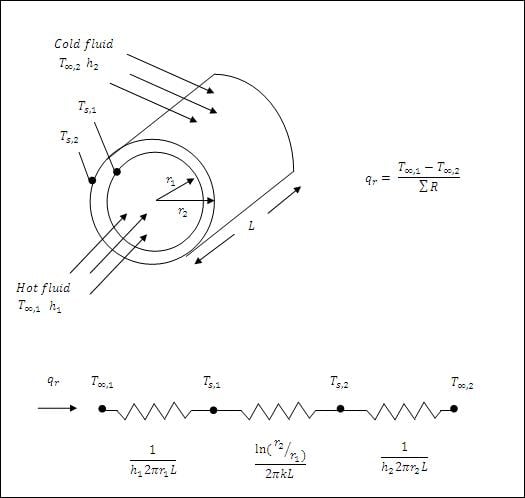
Stainless steel AISI 304 has a conductive heat transfer coefficient (k) equal to 14.9W/mK. Steel is less expensive than stainless steel and would therefore be used in the design however it will be assumed that they have a k value that is approximately equal. In free convection for gases, the convection coefficient (h) is usually between 2 and 25 W/m2K. In forced convection for gases, the convection coefficient is usually between 25 and 250 W/m2K.[12] For this application, h1 will be assumed to be 50 W/m2K because of the slight forcing of air through the pipe caused by the fan and h2 will be assumed to be 5 W/m2K because the pipe would be exposed to calm winds. A steel pipe in an ambient air temperature of 30 degrees Celsius, containing heated air at a temperature of 525 degrees Celsius (cool biomass fire assumption) with inner and outer diameters of 20cm and 25 cm respectively will encounter heat loss of 1.7 kW/m with the outer pipe surface at a temperature of 88 degrees Celsius.
In order to cool one ton of rice at 43 degrees Celsius, air with 14 W of heat must be pushed through the paddy with a 0.7-1.0 W fan.[1] Without information on the heat in Watts produced from the biomass fire, it is difficult to determine whether or not the drying temperature will reach the desired level. However, the inexpensive circular drying bins currently use a similar heat system to produce drying temperatures just above the temperature of ambient air. In addition, the pipe has an additional 90 degree bend which has potential to slow the air, allowing more heat to be lost through the pipe. Given these considerations, the system will likely not produce a temperature higher than the desired level. Drying the rice at a temperature higher than 43 degrees Celsius would have a detrimental effect on the quality of the rice.[1]
Final Design[edit | edit source]
Please note: THIS DESIGN HAS NOT BEEN TESTED
Please refer to the IRRI Example Dryers site to view pictures of the described dryers. The first picture is of the IRRI STR/SRR dryer and the second is of the Vietnamese flat-bed dryer. This new design combines the higher grain quality and fast drying time of the flat-bed dryer and the inexpensive materials and heat source of the circular batch dryers. Frequent mixing of the shallow bed of drying paddy will help reduce the high moisture gradient usually associated to flat bed dryers.
- Advantages: Mixing allows rice to reach a more constant moisture (lowering the moisture gradient) which improves the milling quality, mixing also promotes airflow which increases the velocity over the grains and prevents the heat chamber from becoming too hot (which drastically reduces rice quality), inexpensive and fast-drying
- Disadvantages: No substitute to two-stage dryer, temperatures may peak above the ideal 43 degrees Celsius if mixing is not frequent enough, labor intensive, still slightly more expensive than circular dryer, filter may miss some smoke or other combustion by-products creating smoky rice, power supply required (unlike field and sun drying)
- Notes on Use: Fill top drying bin with 50cm of rice. This reaches the dryer's capacity of one ton. Supply fuel basin with burning rice husk to keep a constant heat source.
- Future work: The fan pulls air through system but makes flow difficult to analyze. A CFD and heat transfer simulation would test assumptions and design validity.
Cost[edit | edit source]
- Fuel basin, pipe, fan, and cloth filter - $100 (estimated)[13]
- Lumber - $25[14]
- Wire mesh - $70[15]
- Bricks - $20 (estimated)
Total estimated cost - $215
Required Materials[edit | edit source]
- Fire basin (approximately 50 cm diameter and 50 cm high) supported by bricks (A)
- Steel piping between 20 cm and 30 cm diameter with 50 cm opening (B)
- Axial flow fan (0.7-1W) (C)
- Smoke filter (same diameter as aluminum piping) (D)
- Plywood (1/2 inch thick)- 2 x 1 m x 0.3 m (E)
- Plywood (1/2 inch thick)- 2 x 1 m x 0.7 m (F)
- Plywood (1/2 inch thick)- 2 x 3 m x 0.3 m (G)
- Plywood (1/2 inch thick)- 2 x 3 m x 0.7 m (H)
- Plywood (1/2 inch thick)- 8 x 0.3 m x 0.1 m cut at 45 degree angles at ends for bracing (I)
- Woven wire meshing or perforated metal (openings no larger than 0.05 inches) – 1 m x 3 m (J)
- Extra bricks to support wire meshing (K)
Required Tools[edit | edit source]
- Power supply for fan
- Nails
- Hammer
- Hand saw
- Measuring tape or meter stick
- Jigsaw (optional)
Construction Instructions[edit | edit source]
References[edit | edit source]
- ↑ 1.00 1.01 1.02 1.03 1.04 1.05 1.06 1.07 1.08 1.09 1.10 1.11 1.12 " Rice Knowledge Bank". International Rice Research Institute. 2009. http://www.knowledgebank.irri.org/rice.htm
- ↑ " Drying Research and Extension". Faculty of Agricultural Engineering and Technology, Nong-Lam University, HoChiMinh City. http://fme.hcmuaf.edu.vn:80/data/drying%20research%20and%20extension.pdf
- ↑ 3.0 3.1 3.2 3.3 "Dryer Descriptions". IRRI. http://www.knowledgebank.irri.org/postproductioncourse/powerpoints/Mod3Drying/Dryerdescriptions.ppt
- ↑ 4.0 4.1 "The SRR-1 dryer: a case study of equipment development in Vietnam". IRRI Discussion Paper Series, 1998. http://books.irri.org/getpdf.htm?book=9712201163
- ↑ " PhilRice Machines". Philippine Rice Research Institute. 2009. http://web.archive.org/web/20131029001146/http://www.philrice.gov.ph/index.php?option=com_content&task=view&id=39&Itemid=65
- ↑ " Maligaya Flatbed Dryer". Open Academty for Philippine Agriculture. 2007. http://web.archive.org/web/20110907073635/http://www.openacademy.ph:80/index.php?option=com_content&task=view&id=1081&Itemid=377
- ↑ " Drying of High Moisture Paddy". FAO Corporate Document Repository. http://www.fao.org/DOCREP/X5427E/x5427e0d.htm
- ↑ "New rice husk furnace takes off in Vietnam". Irrigated Rice Research Consortium, 2007. http://web.archive.org/web/20100704222720/http://www.irri.org/irrc/streams/new%20rice%20husk.asp
- ↑ " Grain Drying". North Dakota State University. http://web.archive.org/web/20120128192411/http://www.ag.ndsu.edu:80/pubs/plantsci/smgrains/ae701-4.htm
- ↑ "Mechanical Dryers: Batch-in-Bin Dryers". FAO Corporate Document Repository. http://www.fao.org/docrep/t1838e/T1838E0W.HTM
- ↑ "Evaporation from Water Surfaces". The Engineering Toolbox, 2005. http://www.engineeringtoolbox.com/evaporation-water-surface-d_690.html
- ↑ 12.0 12.1 "Fundamentals of Heat and Mass Transfer 6th Ed". Incropera et al., John Wiley and Sons, 2007.
- ↑ "Tubing". McMaster-Carr. http://www.mcmaster.com/#tubing/=6prvva
- ↑ "Plywood Prices". Andy's Woodshop. http://www.ezwoodshop.com/plywood/plywood-prices.html
- ↑ "Woven Wire Cloth". McMaster-Carr. http://www.mcmaster.com/#wire-mesh/=6oivhz




